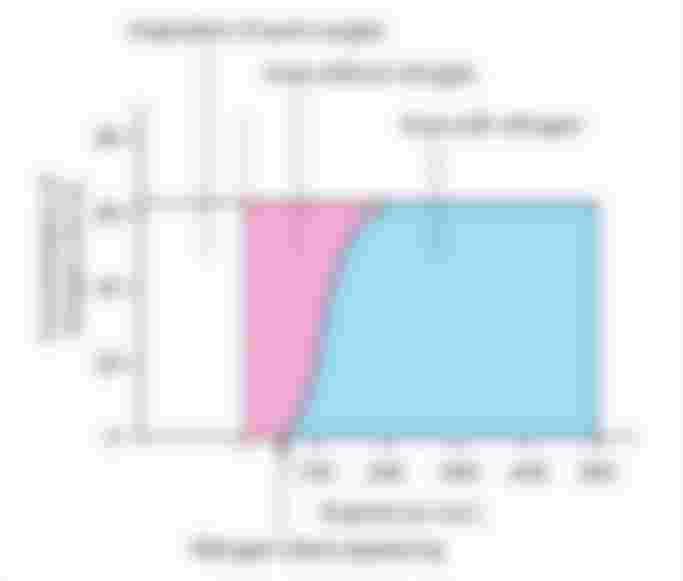VENTILATION
Ventilation, in respiratory physiology, is defined as the rate at which air enters or leaves the lungs; and it is divided into two (2) types:
Pulmonary Ventilation
Alveolar Ventilation
1.) Pulmonary Ventilation:
Pulmonary ventilation is also called minute ventilation or respiratory minute volume. It is the volume of air moving in and out of the respiratory tract in a given unit of time during quiet/calm breathing.
It is a continuous cyclic process whereby fresh air enters the lungs and an equal volume of air leaves the lungs.
In calculating Pulmonary Ventilation, it is a product of Tidal Volume (TV) and the Rate of Respiration (RR). Its normal value is 6,000 mL/minute (6 L/minute).
P.V = Tidal Volume x Respiratory Rate2.) Alveolar Ventilation:
The amount of air used for gaseous exchange every minute is referred to as Alveolar Ventilation. It is different from Pulmonary Ventilation in the sense that out of the 6,000 mL of air that moves in and out of respiratory tract every minute in Pulmonary Ventilation, the whole volume of air is not utilized for gaseous exchange.
In calculating Pulmonary Ventilation, Pulmonary Ventilation is given as the difference between Tidal Volume and Dead Space (we'll talk about this soon) multiplied by the Respiratory Rate. Its normal value is 4,200 mL/minute (4.2 L/minute).
A.V = (Tidal Vol. — Dead Space) × Respiratory RateDEAD SPACE
This subheading sounds like something picked straight out of a Sci-fi movie, but well.. let's shift our mind away from that. Dead space is simply the section of the respiratory tract where exchange of gases does NOT occur. Air present in this section is referred to as dead space air.
It is classified into two (2) types:
Anatomical dead space
Physiological dead space
1.) Anatomical Dead Space:
Anatomical dead space extends from nose up to terminal bronchiole. It includes nose, pharynx, trachea, bronchi and branches of bronchi up to terminal bronchioles. These structures serve only as the passage for air movement. Gaseous exchange does not take place in these structures.
2.) Physiological Dead Space:
Physiological dead space includes anatomical dead space and two additional volumes;
Air in the alveoli, which are non-functioning. In some respiratory diseases, alveoli do not function because of dysfunction or destruction of alveolar membrane.
Air in the alveoli, which do not receive adequate blood flow. Gaseous exchange does not take place during inadequate blood supply.
These two additional volumes are generally considered as wasted ventilation, ie. the volume of air that ventilates physiological dead space. Wasted air refers to air that is not utilized for exchange of gases eg. Dead space air.
Under normal conditions, physiological dead space is equal to anatomical dead space. The volume of normal dead space is 150 mL. All the alveoli are functioning and they receive adequate blood flow in normal conditions. Physiological dead space increases during respiratory diseases, which affect the pulmonary blood flow or the alveoli.
Measuring Dead Space: Nitrogen-Washout Method
This method involves a single breath nitrogen washout method. The subject breathes normally for a few minutes. Then, he takes a sudden inhalation of pure oxygen.
Oxygen replaces the air in dead space (respiratory tract) i.e. the dead space air contains only oxygen and it pushes the other gases into alveoli. Now, the subject exhales through a nitrogen meter.

Nitrogen meter shows the concentration of nitrogen in expired air continuously. First portion of expired air comes from upper part of respiratory tract which contains only oxygen. Next portion of expired air comes from the alveoli, which contains nitrogen. Now, the nitrogen meter shows the nitrogen concentration, which rises sharply and reaches the plateau soon. By using data obtained from nitrogen meter, a graph is plotted. From this graph, the dead space is calculated.

The graph has two areas, area without nitrogen and area with nitrogen. The area of the graph is measured by a planimeter or by computer. The area without nitrogen indicates dead space air.
The formula for calculating Dead Space is given as:

FURTHER READING: Respiratory Physiology: The Essentials (2011) by John B. West





great article and nice photos too